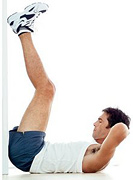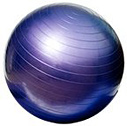Fit To The Core
Find Your Center
By Meghan Vivo
Core Strength Training Is Not Just For Bodybuilders And Those Hoping To Flaunt Rock-Hard Abs This Summer. Even among gym-goers and fitness enthusiasts, the core is one of the most important - but frequently neglected - areas of the body.
While a typical weight-training routine targets and "isolates" an individual muscle, a core workout "integrates" various muscles, which improves full-body strength and flexibility for the regular activities of daily life.
Your core is your center of gravity. The core muscles - the 29 muscles in your pelvis, lower back, hips and abdomen - lie deep within the torso. They generally attach to the spine, pelvis and muscles that support the scapula. Training the core region corrects postural imbalances, prevents lower back pain, improves coordination and body awareness, and reduces tension in the extremities. By contracting the core muscles, you stabilize the spine, pelvis and shoulders, and create a solid base of support for your entire body.
There's no excuse for neglecting your core - you don't need a gym membership or weights, and you only need a few minutes a day. Just check out these portable, versatile tools to strengthen core muscles.
 Exercise Ball
Exercise Ball
Exercise balls are becoming a popular workout aide because they allow for a wide range of motion and constant muscle tension. Since the ball is unstable, it forces the body to adapt to atypical positions to stabilize muscles and bring the body into alignment.
When choosing a fitness ball, size is key. As a general rule, if your hip, knee and ankle line up at approximately a 90-degree angle when you're sitting on the ball, the ball is correctly matched to your height. When in doubt, a 55- or 65-centimeter ball will suit most people. If you're a beginner, choose a softer, larger ball. You can start building your core using the following ball exercises recommended by the Mayo Clinic:
Abdominal Sit-Back
Sit on the ball with your feet resting on the floor, about hip-width apart. Keep your back and neck straight and aligned. Fold your arms across your chest and slowly lean backward until you feel your abdominal muscles contract. Hold this position for three deep breaths and repeat.
 When choosing a fitness ball, size is key.
Bridge
When choosing a fitness ball, size is key.
Bridge
Lie on your back on the floor with your legs resting on top of the ball. Raise your hips and buttocks off the floor into a bridge. Hold this position for three deep breaths and repeat.
Plank
Start out behind the ball, and rest your stomach on the ball with your feet touching the floor. Lean forward until you touch the floor with your hands and walk your hands away from the ball. Stop when you feel the ball reach your upper thighs. Keep your shoulders directly above your hands. Contract your abdominal muscles and hold the position as long as you can while maintaining your balance and form.

